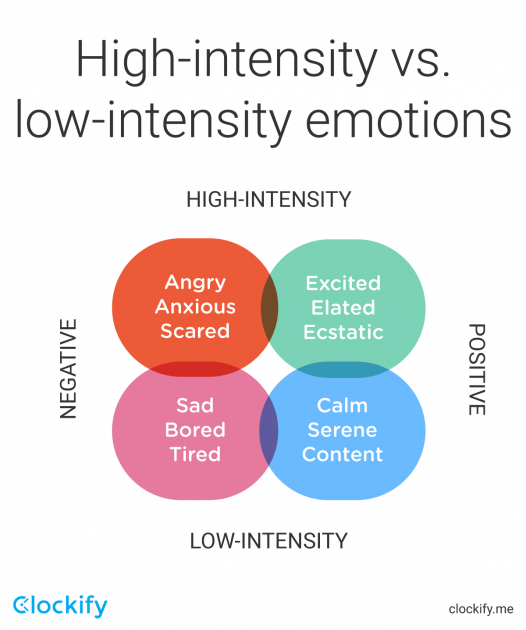Imagine this scenario: your work memories are completely separated from non-work ones. In fact, when you’re at work, you have no recollection of the life you live outside of work.
So, you can’t tell if you have a family, what your hobbies are, or what you do on weekends. Thus, while at work, you aren’t upset or sad if anything bad happens in your private life — because you have no way of remembering your personal life when you’re at the office.
This rather sci-fi story is actually a plot of the TV series Severance, which I highly recommend. Luckily, in real life, our minds and our memory are not so drastically divided between work and free time.
On the flip side, this also means that, whenever we’re going through any kind of a personal crisis, we’ll struggle to stay emotionally stable during work hours. Even when the reason we’re feeling under the weather is job-related, we’ll give our best not to show our emotions at work.
But, how should we manage our emotions in the workplace?
That’s exactly what we’re trying to explore in this blog post, by covering:
- The types of emotions in the workplace,
- Selective vulnerability and how it affects work,
- How to achieve psychological well-being at work, and
- Practical tips on managing emotions at work.

Table of Contents
What are the types of emotions at work?
We can divide emotions at work into four categories:
- Positive and negative emotions,
- Useful and useless emotions,
- High-intensity and low-intensity emotions, and
- Types of emotions according to the Affective Events Theory.
We’ll now explore each category in more detail.
Positive and negative emotions in the workplace
The positive emotions list includes the following feelings:
- Calm,
- Comfortable,
- Energetic,
- Enthusiastic,
- Excited,
- Happy,
- Joyful,
- Peaceful,
- Relaxed, and
- Satisfied.
According to the Quantum Workplace’s research, the most frequent positive emotions employees feel in the workplace are:
- Comfortable — 47.8% of employees,
- Satisfied — 37.1% of employees, and
- Enthusiastic — 36.6% of employees.
On the other hand, the negative emotions list includes the following feelings:
- Annoyed,
- Anxious,
- Bored,
- Disinterested,
- Frustrated,
- Gloomy,
- Sad,
- Stressed,
- Upset, and
- Worried.
💡 Clockify Pro Tip
Although it’s categorized as a negative emotion, boredom can actually have positive effects on your productivity and creativity.
The aforementioned study from Quantum Workplace mentions these negative emotions as the most frequent ones employees feel:
- Frustrated — 56.2% of employees,
- Stressed — 45.1% of employees, and
- Anxious — 30.4% of employees.
Useful and useless emotions in the workplace
According to Biljana Rakic, our very own VP of Human Capital, instead of dividing emotions into positive and negative, we should distinguish between:
- Useful, and
- Useless emotions.
Here’s how Biljana defines useful and useless emotions:

“Useful emotions are the ones that inspire us to be better at work or better at connecting with our colleagues.
Useless emotions are the ones that stand in our way of making any progress at work. These can even be happiness, excitement, or anger and rage.”
She says that sometimes, we can even experience pleasant emotions — like excitement — and have such emotions make us unproductive, despite being pleasant.
In contrast, there are some less pleasant emotions — like shame — that can make us more productive, in a way. For example, we feel ashamed when we do something that isn’t aligned with moral, social, or professional values in the workplace. This shame we feel also inspires us not to make the same mistake again and to be better in the future.
Biljana elaborates:

“Emotions can be unpleasant, and at the same time, they can imply good things. On the other hand, emotions can be pleasant, and simultaneously, they’ll make us unproductive at work.”
Here are some more examples.
We can feel angry when we get an assignment we believe is below our level of qualifications.
Or, we can feel anxious when a manager gives us a task we feel is way above our level of qualifications.
But, as Biljana suggests, fear is what helps us not make a mistake. At the same time, when managers believe we have what it takes to do such a task, they support us in getting out of our comfort zone.
High-intensity and low-intensity emotions in the workplace
Another way psychologists divide emotions is by their intensity — so there are:
- High-intensity emotions, and
- Low-intensity emotions.
For example, positive emotions with high intensity are:
- Excited,
- Elated, and
- Ecstatic.
On the other hand, positive emotions with low intensity are:
- Calm,
- Serene, and
- Content.
Here are some negative emotions with high intensity:
- Angry,
- Anxious, and
- Scared.
In opposition, negative emotions with low intensity are:
- Sad,
- Bored, and
- Tired.

It’s interesting to point out that different cultures have different preferences when it comes to the intensity of emotions.
Namely, as one study on Affect Valuation Theory suggests, European Americans like to feel “excited states” — i.e. excitement, enthusiasm, and elation.
In contrast, Hong Kong Chinese prefer “calm states” — i.e. calm, peacefulness, and serenity, more than European Americans.
Elliot Berkman, professor of psychology at the University of Oregon, mentions in one HBR article that she conducted the study with Jeanne Tsai of Stanford University.
In this survey, they wanted to find out why Americans prefer high-intensity emotions. The results showed that Americans believe that high-intensity emotions are vital if you want to succeed — i.e. to lead or influence.
So, they even adjust the language they use in the workplace when describing the achievement of goals to reflect these emotions. For instance, they use phrases like:
- To get fired up,
- To get pumped,
- To get amped up,
- To crush projects, and
- To crank out presentations.
As you can see, even the language we use can imply our preferred state of emotions at work.
The problem of high-intensity emotions in the workplace
The problem with high-intensity emotions is that, as Berkman claims, they are physiologically demanding.
And, the interesting thing is that both negative and positive emotions with high intensity are physiologically taxing.
For example, excitement is linked with “physiological arousal”, which activates our sympathetic (fight-or-flight) system.
So, whether we are excited (positive) or angry (negative), we’ll experience the same physiological arousal — for instance, our heart rate gets higher.
Thus, Berkman suggests that calm activities are important in all aspects of our lives. Dedicating some time to such activities will restore our health and well-being.
Biljana adds that, from her experience, high-intensity emotions can be tiring for us, especially in the long run.

“What would happen if you were constantly hyped? How long would you be able to go on? Especially if you’re not the kind of person who’s used to experiencing intense emotions.”
She suggests that we should strive to achieve contentment — a state that is usually intertwined with happiness, accomplishment, success, and anticipation.
Such states and such emotions are not too intense, so they won’t prevent us from being productive.

“When we analyze the intensity of traumatic events and how they affect our mental health, we can see that diverse life events, such as childbirth, a divorce, or moving, are similar in intensity. And, we all love experiencing high-intensity emotions because they’re fun — but they’re not good in the long run.”
In a way, Biljana says that we can link high-intensity emotions with emotional labor. She adds that communicating with our coworkers is a type of emotional investment that can make us tired.
Types of emotions according to the Affective Events Theory
Researchers Howard Weiss and Russell Cropanzano created the Affective Events Theory (AET) — the theory that explains the connection between emotions, attitudes, and behavior at work.
According to their findings, there are 6 kinds of emotions in the workplace:
- Anger,
- Fear,
- Joy,
- Love,
- Sadness, and
- Surprise.
The AET explains that different events that occur at work influence different emotions in employees.
As per this theory, diverse emotions can encourage employees to take action. The action can manifest as:
- Affect-driven behavior. For example, a colleague brings you breakfast in the morning. This is a pleasant surprise that you didn’t expect. You’re happy, so you may feel inspired to do something nice yourself — like helping a coworker on a project.
- Judgment-driven behavior. On the other hand, let’s say you get a written reprimand from your manager — for something you didn’t do. You’ll experience negative emotions and, as a result, you might be mean to your coworkers. Or, in more extreme cases, you may even quit your job.
What is selective vulnerability and how does it affect work?
Liz Fosslien, author and illustrator, talks about embracing emotions at work in one of the videos from TED’s series The way we work.
She highlights that, when it comes to emotional expression, there are two types of people in the workplace:
- Under-emoters — people who find it difficult to talk about their feelings, and
- Over-emoters — people who tend to constantly share how they’re feeling.
Fosslien adds that we shouldn’t behave like either of these categories, but rather find a balance between the two extremes.
She talks about the importance of selective vulnerability — expressing your emotions, and at the same time, thinking about the psychological safety of your colleagues.
So, how does this work in practice?
Here are some ways to practice selective vulnerability:
- If it’s a non-work-related event — point out your feelings, but don’t reveal too many details. Fosslien says that it’s better to be honest with your colleagues and let them know why you’re upset, but without any details. You can say: “I’m having a bad day. It has nothing to do with you.”
- If it’s a work-related event — identify what’s going on. For example, if you’re irritable, try to reflect on that and find out why you’re feeling this way. You might be nervous because you’re approaching a deadline. If there’s anything your team members or your manager can do to help you feel better, feel free to reach out to them and say what’s on your mind.
Apart from these suggestions, Fosslien also adds that it’s vital to read the room. If you notice that one of your colleagues is exhausted due to working long hours, be sure to show some empathy.
For instance, ask your manager to postpone a team meeting for a day, so that your colleague has more time to finish work.
How to achieve psychological well-being in the workplace?
When it comes to managing emotions in the workplace, it’s crucial to point out the importance of psychological well-being.
The term “psychological well-being” refers to an individual’s emotional health and overall functioning.
But, what does psychological well-being mean in the workplace? And, how can you achieve it?
We asked Dr. Jack Wiley — Ph.D., an award-winning organizational psychologist, researcher, and leadership consultant.
According to Dr. Wiley, to achieve psychological well-being in the workplace, people must meet three important needs.

“These are the needs for:
- Competence — this means to feel competent at their job, to be able to perform their job according to expectations.
- Relatedness — this means to have stable, supportive, friendly working relations with their manager and co-workers, and to feel that they are an important part of the team.
- Autonomy — this means to be trusted to do their work without micromanagement; to be able to do their work with little intervention, with a reasonable degree of independence.”
He adds that, when managers are attuned to these needs and provide employees with what they want, they enable their employees to thrive and achieve psychological well-being.
Tips for accomplishing competence, relatedness, and autonomy
Dr. Wiley suggests some ways managers can help employees reach competence, relatedness, and autonomy.
According to Dr. Wiley, to help employees satisfy their need for competence, managers should communicate clear performance expectations. Dr. Wiley further explains:

“[Managers should] praise the good work of their employees, reward their performance contributions with better pay, training and development opportunities, and demonstrate skill in helping employees solve work-related problems.”
Now, when it comes to relatedness, Dr. Wiley claims that managers need to show support and understanding. He also adds:

“[Managers should] treat employees with dignity and respect, thank them for their good work, be fair, honest and trustworthy to enable the satisfaction of their employees’ need for relatedness.”
Finally, to help employees satisfy their need for autonomy, here’s what Dr. Wiley suggests managers should do:

“Managers should treat employees with dignity and respect by giving them the psychological space to choose how to do their work, and communicate clear performance expectations, thus defining the performance outcome.”
Dr. Wiley also adds that managers who behave this way will increase employee motivation and accelerate their performance. Besides, their employees will have high levels of employee engagement and positive interpersonal team chemistry.
💡 Clockify Pro Tip
For more details on how to track employee performance and create performance standards in your company, check out the following articles:
How to manage emotions in the workplace
Finally, let’s go through some practical tips on how to manage emotions in the workplace.
We reached out to experts in the field of human resources, sociology, and psychotherapy, to hear their invaluable opinion.
Tip #1: Don’t let emotions lead you — you lead them
We asked Biljana whether it’s acceptable to show our emotions in the workplace, or if we should suppress them — especially when we’re sad or angry.
She believes that depends on the company culture.
Namely, a healthy company culture supports expressing emotions — but these feelings shouldn’t be high in intensity.
Biljana adds:

“How can we tell the intensity of our emotions? One way is — we shouldn’t let emotions lead us, we should lead them.”
For example, you’re angry at a coworker and get into conflict with that person.
You do so because the emotion is still here, you still feel it.
After some time, you’ll figure out that you said something hurtful while being angry, so you’ll want to apologize to your coworker.
This means that the intensity of our emotions during the conflict was not appropriate.
So, this is how we know whether an emotion is appropriate at work:

“If we regret our actions, this indicates that the intensity of emotions is not appropriate for the workplace. Thus, we need to be able to figure out whether we’re in tune with our feelings — if we feel good or not. It’s also worth noting that we shouldn’t give feedback or make decisions while we’re overwhelmed with intense emotions.”
Tip #2: Nurture a company culture that encourages expressing emotions
Another valuable piece of advice Biljana has shared with us is that companies shouldn’t punish their employees for experiencing particular emotions — even when these emotions are anger or frustration.
She claims that company culture should encourage employees to experience their emotions when needed, instead of suppressing them.
For instance, if you’re furious after a meeting, you should be able to take a moment for yourself and go for a brief walk. This way, you’ll allow yourself to feel this anger — and, after a while, let this anger go away. In turn, as other coworkers likely aren’t experiencing the same emotions as you currently are, you won’t risk upsetting them.
It’s also important not to suppress your emotions because emotions always convey particular messages, as Biljana claims:

“Anger is always a request for a change of behavior. Rage implies losing control. For instance, when parents yell at their children — they do so because they’re losing control.”
Biljana concludes that expressing our emotions at work is vital for our mental health.
However, keep in mind that we shouldn’t allow these emotions to affect our colleagues.
We need to be aware that our emotions can sometimes be too intense for the people we work with.

“I recommend sharing emotions and always keeping in mind why we share them.”
In addition, the company culture should encourage employees to initiate sessions with their managers and talk about how they feel. It’s up to managers to create a trusting atmosphere where employees will feel comfortable opening up.
💡 Clockify Pro Tip
The matter of trust is a tricky one, especially in a remote work setting. If you need any help in this area, check out the following blog post:
Tip #3: Think about the goal of sharing your emotions and who you are sharing them with
Now, should we talk about our feelings in front of our team?
Or, should we leave such conversations for one-on-one sessions with our manager?
It all depends on the goal we’re trying to achieve, Biljana believes.
If we’re sharing our emotions with our managers, we expect some kind of reaction from them.
For instance, we may want to talk to our manager about the tasks we’re doing if we need more time for them or require any other kind of modification.
Biljana continues:

“Managers are in a position of power. Thus, when we’re talking with our managers, we expect them to change the current situation. A manager shouldn’t be our shoulder to cry on, but a person who can take actions that will help us.”
When it comes to sharing our emotions with team members, Biljana thinks that we also have to figure out why we’re doing that. One of the reasons can be that we need support from our team members.
In general, she claims that sharing emotions with your team depends on:
- The relationship between team members,
- The team leader,
- The topic, and
- The goal we’re trying to achieve.
As mentioned earlier, the company culture should support sharing emotions within the team. As for the team members, they should be honest with each other.
Biljana further explains that there are moments when we can’t avoid or prevent high-intensity emotions — for example, when we find out that our work bestie got fired. When that happens, it’s crucial that other team members give enough time and space to a person experiencing intense emotions.
Tip #4: Create a “psychologically safe” environment for everyone
This tip mainly refers to managers and team leads.
According to Biljana, it’s up to them not to judge any kind of emotion. Moreover, they should create an environment that encourages employees to share their emotions.
Here’s why that’s important in the workplace:

“Employees need to feel ‘psychologically safe’. So, when someone’s feeling under the weather or simply tired, they should be able to share that feeling with coworkers and managers. Furthermore, nobody should take advantage of that information.”
This environment ensures that employees feel psychologically safe and that they’re allowed to make mistakes occasionally.
How exactly can you create such an atmosphere within the company?
Biljana highlights one key aspect — trust. This is one of the most important values managers need to promote.
Thus, team leads should:
- Be there for their team and support them emotionally,
- Educate their employees so that they can advance their careers,
- Teach their employees how not to make the same mistakes, and
- Keep the focus on what employees are good at — i.e. their strengths.
This way, managers create an environment where employees feel comfortable sharing how they feel, without any judgment.
Tip #5: Learn how to share openly and help others manage their own emotions
In the opinion of Daphne Pedersen, a Ph.D., Professor of Sociology, and Department Chair at the University of North Dakota, managing emotions in the workplace is important to our professional development and success, and the healthy operation of the organization.

“It’s up to employees and managers to effectively cope with the immediate physical response our bodies have to strong positive and negative feelings so we can effectively communicate. This can be done in a number of ways, including:
- Pausing and taking a deep breath,
- Taking some time to reflect and putting a pause on a conversation or email, and
- Trying to take the perspective of the person we are engaging with.”
She highlights that, in the long run, managers need to be aware that the ability to share openly in constructive ways is critical to a healthy workplace environment and employee performance.
Pedersen shares another thing you should keep in mind:

“Being good at emotional labor is also important — this can be seen as a type of emotional intelligence. Emotional labor is the ability to rein in our emotions to have appropriate professional interactions and can sometimes involve helping others manage their own emotions, like frustration or anger.”
💡 Clockify Pro Tip
If you’d like to learn what emotional labor is and what it isn’t, as well as how to deal with it, check out our in-depth article on this subject:
Tip #6: Take a three-step approach to deal with negative emotions
Now, if you’d like to beat negative emotions, here’s how you can do that in three steps:
- Recognize emotions,
- Understand them, and
- Manage your reaction to such emotions.
Step #1: Recognizing emotions
When emotions start to emerge, take a deep breath and try to recognize what you’re feeling.
Also, try to identify what triggered the emotion.
Whatever emotions you’re experiencing, don’t judge yourself for feeling them.
Step #2: Understanding emotions
Now that you’ve recognized the emotion you’re feeling, try to understand why you’re feeling it.
Here are the questions that can help you along the way:
- What is causing you to feel such emotion?
- Are the emotions triggered by internal or external factors?
- Is the emotion familiar to you?
When it comes to familiar emotions, you can recall previous situations when you felt the same. Then, try to remember how you responded to it.
This way, you’ll be able to reflect on your previous experiences and think about whether you’d like to respond to such emotions differently this time.
Step #3: Managing emotions
The final step involves responding to the emotion you’re currently experiencing.
Here are some questions you’ll find useful:
- Do you still feel the need to deal with these emotions?
- Did you overreact?
- Is there anything you still need to resolve to better manage your emotions?
- How are you going to express your emotions, and how might others react?
- What did you learn from previous experiences, and how can you apply that knowledge?
Hopefully, once you go through these questions, you’ll have a better understanding of how to respond to emotions.
Tip #7: Model positive emotional management
Valentina Dragomir is a psychotherapist and founder of PsihoSensus Therapy and PsihoSensus Academy.
She specializes in emotional intelligence and helps her clients efficiently manage their emotions, at home and in the workplace.
In Valentina’s opinion, it’s important to be able to manage both positive and negative emotions in the workplace to be successful.

“If you are feeling overwhelmed by negative emotions, it is important to take a step back, calm down, and, after you are able to see things more clearly, assess the situation. Once you have identified the source of the problem, you can take steps to address it.”
She points out that managers need to encourage employees to express their emotions.

“This can help prevent a build-up of negative emotions and allow for productive problem-solving.
Also, model positive emotional management. As a manager, you can set the tone for how emotions are handled in the workplace.”
Another valuable point Valentina has mentioned is that team leads should encourage breaks and regular check-ins. Thus, employees will be able to avoid burnout.
Wrapping up: Share your emotions while having a clear goal in mind
We’re humans, and as humans, it’s only natural that we’ll sometimes feel angry, anxious, or sad, because of work-related or non-work-related events.
Now, should you express such emotions in the workplace?
If it’s about a non-work event, it’s always better to be honest with your colleagues and tell them how you’re feeling without revealing too many details. That way, you’ll practice selective vulnerability.
If it’s about a work-related event, you should try to figure out why you’re feeling that way, and ask for help from colleagues if needed.
It’s crucial to point out that we shouldn’t let emotions lead us, but we should lead them. Also, when we’re experiencing intense emotions, we should avoid making decisions or giving feedback.
Another point worth mentioning is that employees need to be able to express their emotions freely — at the same time, they should think about the goal of sharing such emotions and the people they’re sharing them with.
It’s up to managers to model positive emotional management so that workers are comfortable expressing how they feel.
Apart from managers, company culture plays a vital role in emotional management. But, bear in mind that these emotions shouldn’t be high-intensity.
We hope that the tips we covered in this article will help you manage your emotions more effectively in the workplace. Once you’re able to do so, you’ll also find it easier to help your coworkers speak up about how they’re feeling.
✉️ What about you? Do you share your emotions in the workplace, or do you suppress them? Does your company culture support expressing emotions? Let us know at blogfeedback@clockify.me, and we may include your answers in this or future posts.


